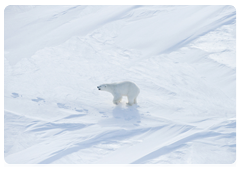MULTIMEDIA
 +
+
Humans have known of the existence of polar bears since the time of ancient Rome (the 1st century A.D.). The historical records of Japanese emperors offer evidence that polar bears and their skins were brought to Japan and Manchuria in the 7th century A.D.
 +
+
The polar bear was placed on the IUCN (International Union for the Conservation of Nature) Red List of Threatened Species and the Russian Red List of Threatened Species. Currently, polar bear hunting in Russia is completely prohibited, whereas in the United States, Canada and Greenland it is only restricted
 +
+
In 1774, British zoologist Konstantin Phipps was the first to describe the polar bear as a separate species
 +
+
The indigenous population of the Arctic has been hunting these animals for as long as anyone can remember. However, as humans have become more active in the North, polar bear numbers have declined and polar bear hunting is now prohibited with few exceptions
 +
+
On November 21, 1956, the R.S.F.S.R. (the Russian Soviet Federative Socialist Republic, a union republic included as part of the U.S.S.R.) Council of Ministers signed a resolution in which the first item declared a prohibition on polar bear hunting beginning in 1957
 +
+
In 1960, a wildlife reserve was established on Wrangel Island, one of the major polar bear breeding sites, and in 1976 the state-run Wrangel Island Nature Reserve was created there
 +
+
In 1973, Arctic countries signed the Agreement on the Conservation of Polar Bears and Their Habitat ; since being ratified and coming into effect in 1976, this agreement has served as an international legal foundation for protecting, researching and managing this species
 +
+
In October 2000, the Russian and U.S. governments signed the Agreement on the Conservation and Management of the Chukotka-Alaska Polar Bear Population
 +
+
Photos taken during an expedition of scientists from the Institute of Ecology and Evolution, which was the first in Russia to start using satellite-linked transmitters for polar bear studies
 +
+
Photos taken during an expedition of scientists from the Institute of Ecology and Evolution, which was the first in Russia to start using satellite-linked transmitters for polar bear studies
 +
+
Photos taken during an expedition of scientists from the Institute of Ecology and Evolution, which was the first in Russia to start using satellite-linked transmitters for polar bear studies
 +
+
Photos taken during an expedition of scientists from the Institute of Ecology and Evolution, which was the first in Russia to start using satellite-linked transmitters for polar bear studies
 +
+
Photos taken during an expedition of scientists from the Institute of Ecology and Evolution, which was the first in Russia to start using satellite-linked transmitters for polar bear studies
 +
+
Photos taken during an expedition of scientists from the Institute of Ecology and Evolution, which was the first in Russia to start using satellite-linked transmitters for polar bear studies
 +
+
Photos taken during an expedition of scientists from the Institute of Ecology and Evolution, which was the first in Russia to start using satellite-linked transmitters for polar bear studies
 +
+
The World Wildlife Fund (WWF) puts the number of polar bears in the world at 20,000 to 25,000. However, already by 2050 the polar bear population may be diminished by two-thirds
 +
+
The oldest written source found in Northern Europe containing information about polar bears dates back to approximately 880 A.D.: at that time two polar bear cubs were brought from Norway to Iceland





 ABOUT THE PROGRAMME
ABOUT THE PROGRAMME
 POLAR BEAR RESEARCH: A HISTORY
POLAR BEAR RESEARCH: A HISTORY
 POLAR BEAR: LIFE, BEHAVIOUR AND MORE
POLAR BEAR: LIFE, BEHAVIOUR AND MORE
 VLADIMIR PUTIN'S VISIT
VLADIMIR PUTIN'S VISIT
 NEWS
NEWS
 MULTIMEDIA
MULTIMEDIA